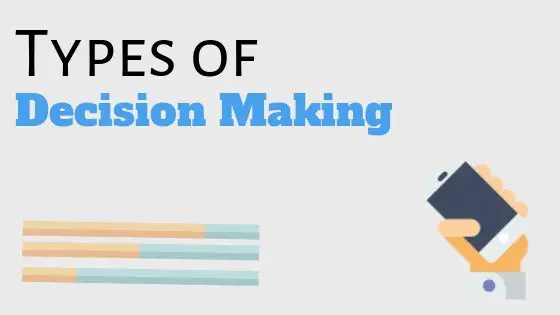In business, effective decision-making stands as a cornerstone of success. Managers are faced with a myriad of choices on a daily basis, each with potential consequences that can shape the course of their organizations. The art of decision-making in management extends beyond mere intuition, encompassing a range of methodologies tailored to specific scenarios.
Decision-making is an intellectual process for the selection of the best alternative from two or more alternatives to reach the desired result.
The decision is classified into several categories, according to their methods, thinking, and requirements.
Decisions can range from the tactical to the strategic, from operational choices that impact day-to-day activities to transformative ones that shape the organization’s long-term direction.
Whether it’s selecting a new supplier, launching a product, or redefining the company’s mission, every decision carries a weight that reverberates throughout the organization and beyond.
What are the Various Types of Decision-Making?
Following are the various types of decision-making approaches in management, shedding light on their advantages, disadvantages, and real-world applications.
1. Routine and Basic Decision Making
Routine decision-making means such decisions, which are taken in respect of the day-to-day activities of the organization and which require less thinking and advice. These are of a repetitive nature.
Basic decision-making means such decisions that are essential for the existence of the organization and for which complete study, analysis, power, and critical thinking are essential.
2. Rational Decision-Making
Rational decision-making is often touted as the gold standard in managerial circles. Rooted in a systematic process, this approach involves a sequence of steps designed to optimize outcomes.
The process typically includes:
- Problem Identification: Clearly defining the problem or opportunity that requires a decision.
- Identification of Alternatives: Generating a pool of potential solutions or courses of action.
- Evaluation of Alternatives: Weighing the pros and cons of each alternative based on relevant criteria.
- Selection of Alternative: Opting for the alternative that best aligns with organizational goals and criteria.
- Implementation: Executing the chosen alternative.
- Evaluation: Assessing the outcomes of the decision to determine its effectiveness.
Rational decision-making, while logical and methodical, requires access to accurate and comprehensive information. Additionally, this approach assumes that individuals possess the cognitive ability to evaluate all available options thoroughly.
3. Intuitive Decision-Making
Contrasting with the deliberate process of rational decision-making, intuitive decision-making relies on instinct and gut feelings. It’s often associated with experienced managers who draw upon their knowledge and past experiences to make quick judgments.
This approach can be effective when time is limited or when dealing with complex and uncertain situations where data might be lacking.
Intuitive decision-making, however, is not foolproof. Biases and emotions can influence decisions, leading to suboptimal outcomes.
To mitigate these risks, managers practicing intuitive decision-making should be self-aware and actively work to hone their intuition through ongoing learning and reflection.
4. Personal and Organizational Decision Making
The decisions that are taken by any person in his personal capacity, and not as a member of the organization are known as personal decisions, for example, decisions for leave, dress, resigning from the organization and accepting or rejecting promotions, etc.
The organizational or institutional decisions are which are taken by the executives or officers in their formal capacity and which may be delegated to other persons.
Such decisions directly affect organizational behavior.
5. Individual and Group Decision Making
When the size of the business unit is small and the decisions to be taken do not require high, specific, and technical knowledge, then the decisions for various problems are normally taken by the managers themselves.
Such decisions are known as individual decision-making techniques.
Group decision-making techniques mean such decisions which are not taken by a single individual, but by a group.
This is known as participating decisions which are known as individual decision making.
6. Bounded Rationality
Herbert Simon introduced the concept of bounded rationality, acknowledging that humans have limitations in processing vast amounts of information when making decisions.
In essence, individuals make decisions that are “good enough” given their cognitive constraints. Bounded rationality recognizes the need to simplify decisions by focusing on only the most relevant information.
This approach aligns with the real-world complexity managers often face. While it helps streamline decision-making, it’s important to be cautious of omitting critical details due to the simplified perspective.
7. Incremental Decision-Making
Incremental decision-making emphasizes small, gradual changes rather than drastic shifts.
This approach is particularly suitable for situations where the outcomes are uncertain, and there’s a need to test the waters before committing fully. It’s common in situations where stakeholders are resistant to change or when organizations are risk-averse.
However, incremental decisions can lead to complacency and hinder innovation. Striking the right balance between incremental and transformative decisions is crucial for sustained growth.
8. Policy and Operating Decision Making
Policy decisions are those which relate to the basic policies of the organization and these are taken by the top management or board of directors.
Such decisions are also known as management decisions or basic decisions.
Operating decision-making is with respect to decisions relating to the general affairs of the institution or enterprise and is of a mechanical nature.
Such decision-making is also known as executive or current decision-making because they are helpful in the execution of policy decisions.
9. Participative Decision-Making
Recognizing that decisions can impact various levels of an organization, participative decision-making involves involving multiple stakeholders in the process.
This approach fosters collaboration, encourages diverse perspectives, and can lead to higher levels of commitment to the chosen course of action.
While participative decision-making can be time-consuming, the shared ownership of decisions often leads to better implementation and greater acceptance among team members.
10. Groupthink and Consensus
Group decisions can sometimes veer towards the pitfalls of groupthink – a phenomenon where the desire for harmony within a group overrides critical analysis of alternatives.
To counter this, consensus decision-making aims to achieve agreement while encouraging dissenting viewpoints. This process encourages thorough exploration of options and enhances decision quality.
11. Programmed and Non-Programmed Decision Making
Programmed decision-making is of a repetitive and routine nature and is taken through some well-decided and well-organized system, so that when the problem arises, it may be solved by using that method.
Non-programmed decision-making is not a routine or repetitive nature. These are unique and new and they have a long-lasting effect on the organization.
This decision-making is based on traditional methods, and not on the predecided procedure.
12. Planned and Unplanned Decision-Making
Decisions for which Advance preparation is done, are based on the collection of facts, analysis, and scientific methods and are known as planned decision-making.
Unplanned decision-making technique means Such decisions for which no plan is made, But are necessary, according to the circumstances, problems, and opportunities that prevailed.
13. Data-Driven Decision-Making
In the era of big data, organizations are increasingly leveraging data-driven decision-making.
This approach involves mining and analyzing data to uncover patterns, trends, and insights that guide decisions. Data-driven decisions are objective and grounded in evidence, reducing the influence of biases.
However, data-driven decisions are only as good as the quality of data and the accuracy of analysis. The potential for misinterpretation and reliance on irrelevant metrics remains a challenge.
14. Ethical Decision-Making
Ethical considerations play a significant role in decision-making, especially as organizations face growing scrutiny regarding their social and environmental impact.
Ethical decision-making involves evaluating options based on moral principles, transparency, and the long-term consequences of choices.
Ethical dilemmas can be complex, requiring managers to navigate between profitability and societal responsibility. Integrating ethical considerations into decisions can foster a positive organizational culture and enhance stakeholder trust.
15. Tactical and Strategic Decision Making
Tactical decision-making is of a routine nature, related to normal day-to-day activities, and is of relatively lesser significance.
For these decisions, the options are limited and do not require much analysis and evolution. A strategic decision-making technique is those decisions, which are very difficult to be taken.
This affects the future of the business and is related to the whole Organization.
In other words, these are the decisions, that are taken presently, but their primary effect is observed after some time.
16. Crisis Decision-Making
Crises demand swift decisions under extreme pressure. Crisis decision-making requires a balance between rational assessment and quick action.
Established crisis management protocols, simulation exercises, and scenario planning can aid in making effective decisions in high-stress situations.
However, the urgency of crisis decision-making can lead to hasty judgments. Reflection and review post-crisis are crucial to extract lessons and improve future responses.
17. Autocratic Decision-Making
In this top-down approach, a single individual or a small group holds the decision-making authority.
Autocratic decision-making is efficient in terms of speed but can stifle creativity and hinder employee engagement.
It’s best suited for situations requiring rapid responses or when the decision-maker possesses specialized expertise.
18. Organizational, Departmental Decisions Making
Organizational decision-making means such decisions which are taken by the higher authorities of the Institution and affect the whole organization or enterprise.
Such decision-making is also known as enterprise decision-making. Departmental decision-making is for those decisions which affect the operation of the whole department of an enterprise and its employees.
Such decisions are taken by department managers, the chairman, or management.
Inter-departmental decision-making is those decisions that are taken by the higher authorities/chairpersons/representatives of two or more departments of the organizations, after mutual deliberations.
Conclusion:
Effective decision-making is the cornerstone of successful management. From rational and intuitive approaches to participative and ethical considerations, the multitude of decision-making methods reflects the diverse nature of challenges that managers face.
There’s no one-size-fits-all solution; the key lies in understanding the nuances of each approach and applying them judiciously based on the context at hand.
In a rapidly evolving business landscape, mastering the art of decision-making equips managers to navigate uncertainties and drive their organizations toward sustainable success.



Interesting write up, i have learnt a whole lot from this article. I shall keep coming back to read up more of your resources
What an interesting article, kindly keep this up!!!
We are happy to help you
The Different Types of Decision Making in an Organization was accurately indicated in the write up. I look forward to more of this kind of article.
im happy to see you here… how can I help you again
Wow! Just what I was looking for, thank you!
Beautiful content, keep it up!
I actually needed information like this to grow, thank you!
I actually needed information like this to grow, thank you!
Interesting content you have here, I have learnt so very much from your article. I will be coming to get some more from your resources
Seriously, this article is a very interesting one! It’s helpful to me and I love it. I will bookmark it, thank you!
Meanwhile, am here at:
https://researchwap.com
https://researchwap.net
https://researchwap.org